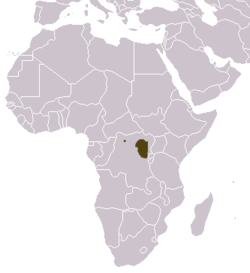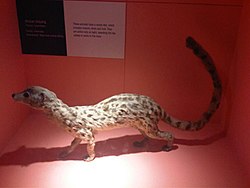| Genus | Species | IUCN Red List status and distribution |
|---|
| Genetta Cuvier, 1816 [1] | Common genet (G. genetta) (Linnaeus, 1758) [2]
 | LC [3]
 |
Cape genet (G. tigrina) (Schreber, 1778) [4]
 | LC [5]
 |
| South African small-spotted genet (G. felina) (Thunberg, 1811) [6] |
Rusty-spotted genet (G. maculata) (Gray, 1828) [7]
 | LC [8]
 |
Pardine genet (G. pardina) Geoffroy Saint-Hilaire, 1832 [9]
 | LC [10]
 |
Abyssinian genet (G. abyssinica) (Rüppell, 1835) [11]
 | DD [12]
 |
King genet (G. poensis) Waterhouse, 1838 [13]
| DD [14]
 |
Servaline genet (G. servalina) Pucheran, 1855
 | LC [15]
 |
Angolan genet (G. angolensis) Bocage, 1882
 | LC [16]
 |
Giant forest genet (G. victoriae) Thomas, 1901 [17]
 | LC [18]
 |
Hausa genet (G. thierryi) Matschie, 1902 [19]
 | LC [20]
 |
| Letaba genet (G. letabae) Thomas and Schwann, 1906 [21] |
| Johnston's genet (G. johnstoni) (Pocock, 1908) | NT [22]
 |
Aquatic genet (G. piscivora) (Allen, 1919) [23]
 | NT [24]
 |
Crested servaline genet (G. cristata) Hayman, 1940
 | VU [25]
 |
| Schouteden's genet (G. schoutedeni) Crawford-Cabral, 1970 |
| Bourlon's genet (G. bourloni) Gaubert, 2003 [26] | VU [27]
 |
| Poiana Gray, 1864 [28] | Central African oyan (P. richardsonii) (Thomson, 1842) [29]
 | LC [30]
 |
| West African oyan (P. leightoni) (Pocock, 1907) [31] | VU [32]
 |



























